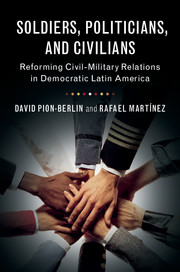Book contents
- Soldiers, Politicians, and Civilians
- Soldiers, Politicians, and Civilians
- Copyright page
- Dedication
- Contents
- Figures
- Tables
- Acknowledgments
- Introduction
- 1 Military Reform, Civil-Military Relations, and Democratization
- 2 Civil-Military Developments in the Southern Cone and Brazil: An Overview
- 3 Reducing Military Power
- 4 Devising a New Legal Framework
- 5 Building Defense Institutions
- 6 Generating Knowledge
- 7 Achieving Convergence
- 8 Achieving Effectiveness
- 9 Explaining Civil-Military Relations Reform
- Select Bibliography
- Index
- References
Select Bibliography
Published online by Cambridge University Press: 28 September 2017
- Soldiers, Politicians, and Civilians
- Soldiers, Politicians, and Civilians
- Copyright page
- Dedication
- Contents
- Figures
- Tables
- Acknowledgments
- Introduction
- 1 Military Reform, Civil-Military Relations, and Democratization
- 2 Civil-Military Developments in the Southern Cone and Brazil: An Overview
- 3 Reducing Military Power
- 4 Devising a New Legal Framework
- 5 Building Defense Institutions
- 6 Generating Knowledge
- 7 Achieving Convergence
- 8 Achieving Effectiveness
- 9 Explaining Civil-Military Relations Reform
- Select Bibliography
- Index
- References
- Type
- Chapter
- Information
- Soldiers, Politicians, and CiviliansReforming Civil-Military Relations in Democratic Latin America, pp. 342 - 382Publisher: Cambridge University PressPrint publication year: 2017



